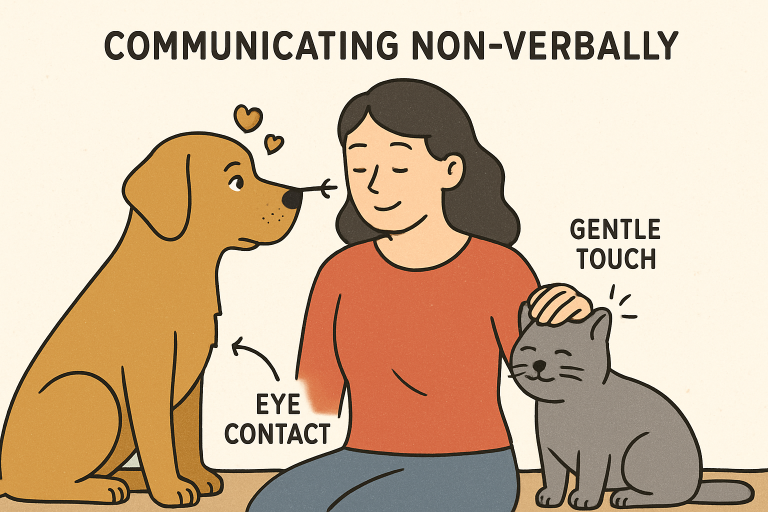Key Takeaways
- • Pets communicate primarily through behavior, body language, and vocal cues, making attentive observation essential for early detection of health or emotional issues.
- • Technological innovations, such as pet communication devices and AI tools, are revolutionizing how owners understand their pets’ needs and emotions.
- • Emotional synchrony between pets and owners highlights how deeply connected they are—stress or calmness in one often mirrors in the other.
- • Learning to interpret vocalizations and body language helps identify stress, discomfort, or happiness, promoting better care and responsiveness.
- • Maintaining consistent routines and stable environments reduces anxiety and supports emotional balance in pets.
- • Veterinarians or pet behaviorists should assess persistent behavioral changes to rule out medical or psychological concerns.
- • Leveraging both human intuition and modern tools enhances trust, empathy, and communication between pets and their owners.
- • Ultimately, proactive and mindful engagement fosters a stronger, healthier, and more rewarding relationship between humans and their pets.
Recognizing Behavioral Indicators
Our pets can’t use words, but they speak to us in countless other ways. Careful observation is crucial, as pets often display early warning signs through behavioral changes that can indicate shifts in their health or mood. When a typically energetic dog suddenly withdraws or seems less interested in playing, this may indicate underlying health concerns. In such cases, identifying a lethargic dog early can expedite treatment and recovery. Similarly, cats that start to hide or change their eating habits are sending clear messages about their well-being, even if these cues are easily missed in a busy household.
Attentive owners often become experts at reading these non-verbal signals over time. For example, destructive behavior, restlessness, or a newly developed fear of noises can also be a pet’s way of telling you something is wrong. Recognizing subtle shifts not only improves your pet’s health outcomes but can also prevent minor issues from becoming primary concerns. By prioritizing close observation, you can help maintain both physical and emotional stability for your furry companion.
Technological Advances in Pet Communication
The growing bond between humans and their pets has inspired a new wave of research and development in the pet care industry. One of the most exciting advances is the rise of interactive communication devices, such as soundboards with “speak” buttons. Pioneered by researchers at the University of California, San Diego, these tools allow pets to express a range of wants and needs, from “food” and “walk” to more complex thoughts. The implications could be game-changing. Early results demonstrate significant promise, with some pets showcasing surprising communication abilities once introduced to these new devices.
These technological advances are not just about giving pets a voice in the literal sense—it’s about empowering pet owners to understand better what their animals are experiencing. As artificial intelligence and machine learning are integrated into pet care routines, the hope is to bridge the communication gap and prompt earlier intervention should any issues arise. Major publications, such as The Atlantic and NPR, have reported on these innovations, pointing to an era where pets might finally have the tools to inform their owners precisely how they feel.
Emotional Synchrony Between Pets and Owners
The relationship between pets and their owners extends far beyond physical presence, encompassing a remarkable degree of emotional and physiological connection. Groundbreaking studies, such as those highlighted in Harvard Health, reveal that pets and people often mirror each other’s heart rate variability during times of interaction. This synchrony is not only a testament to their deep bond but also a tangible indicator of shared emotional well-being. For instance, a stressed owner may inadvertently influence the mood and stress levels of their pet, and vice versa.
The emotional ripple effect within a pet-owner relationship often surfaces during heightened moments—be it excitement, anxiety, or even illness. Learning to recognize these patterns can foster empathy and more effective care, underscoring the importance of mental health awareness for both parties in the relationship. Researchers at the American Kennel Club note that dogs are particularly adept at responding to their owners’ emotions, a phenomenon supported by years of anecdotal evidence and emerging scientific research.

Interpreting Vocalizations and Body Language
Understanding the meaning behind a pet’s vocal cues and body postures is vital. Dogs’ barks, growls, and whimpers, or cats’ meows, hisses, and purrs, each cover a broad spectrum of emotions. Deciphering these cues can help dogs and cats manage stress or alert owners to underlying problems. For example, excessive vocalization may indicate pain or discomfort, while a sudden change in tail position or avoidance of eye contact can signal insecurity or distress. According to the American Veterinary Medical Association, recognizing these subtle cues can significantly enhance an owner’s ability to meet their pet’s needs.
The Role of Routine and Environment
Environmental stability plays a significant role in your pet’s overall well-being. Disruptions such as moving house, changes in household members, or a new work schedule can cause confusion and anxiety in pets. These changes often manifest through altered eating patterns, excessive grooming, or even household accidents. Maintaining familiar routines, providing safe hiding places, and gradually introducing new environments can alleviate much of this stress, as emphasized by experts from the Humane Society.
Seeking Professional Guidance
If you observe lasting changes in your pet’s behavior, reaching out to a veterinarian or certified pet behaviorist is highly recommended. These professionals can conduct thorough assessments, ruling out medical issues before exploring behavioral interventions. Early intervention helps ensure the well-being of the pet while reducing the risk of chronic health conditions or ingrained behavioral problems. Exploring resources provided by organizations like the American Society for the Prevention of Cruelty to Animals (ASPCA) can also provide guidance and practical tips.
Enhancing the Human-Pet Bond
Mindful observation, a willingness to embrace new technologies, and seeking expert help when needed are key strategies for boosting the relationship you share with your pet. An enhanced understanding fosters trust, security, and happiness on both sides. It is through such conscious care that pets and their owners achieve the most fulfilling companionship possible, rooted in effective communication and mutual respect.
In summary, pets continuously communicate their needs and well-being through behavior, body language, and even technology. By being receptive and proactive, pet owners can ensure that their beloved companions receive the care and attention they need, creating a lasting, meaningful bond that stands the test of time.
